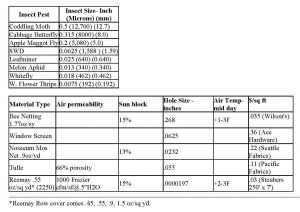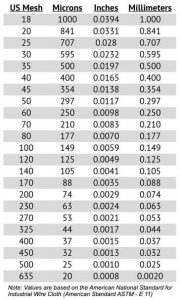Tulle – A Cool Tool
September 3, 2018
 Stretching the parameters of our climate is part of gardening. We add row covers or netting to keep out a pest or alter sunlight transmission. But it’s not that simple is it? These tools can affect soil and air temperature, humidity, wind, light penetration, pollination, and productivity. Did you know red shade cloth can increase productivity of tomatoes.
Stretching the parameters of our climate is part of gardening. We add row covers or netting to keep out a pest or alter sunlight transmission. But it’s not that simple is it? These tools can affect soil and air temperature, humidity, wind, light penetration, pollination, and productivity. Did you know red shade cloth can increase productivity of tomatoes.
For example, installing a row cover with a mesh size to keep the white fly off your Brussels sprouts  will most assuredly cause a decrease in sunlight and wind, and a mid-day increase in humidity and air and soil temperature.
will most assuredly cause a decrease in sunlight and wind, and a mid-day increase in humidity and air and soil temperature.
The impacts that row covers and netting have on plants are significant. Seeds need a certain soil temperature to germinate successfully(1). Better ventilation helps reduce air temperature and humidity and improves the evapotranspiration process for crops (plants sweat through their leaves).
In short, well, there is no “in short” to this topic. It’s complex. Try figuring out how to relate the Frazier measurement of air permeability to the discharge coefficient. Note the gaps in my chart!
Sun, Sep 16, 2-4, Work Party
Sat, Oct 6, 2-5, Cider Fest!
Sun Oct 21, 2-4, Work Party
I had to call an engineer, who settled the air permeability issue for me. “Just take your shop vac, put the hose on the other end so it blows out and hold the fabric up near your face. You will feel which fabric has better permeability.”
By the way, if you get stubborn and want to figure this stuff out, know that there is a pretty good relationship, with very thin fabrics, between porosity and air permeability. And, there is a pretty good relationship between water permeability and air permeability. Try putting the fabric in your coffee filter holder, run water through and time each fabric.
For an overview, here’s a link to a general article about agrotextiles from Textile World, http://www.textileworld.com/textile-world/nonwovens-technical-textiles/2005/09/agrotextiles-a-growing-field/ However, there is nothing in the article about Tulle. Tulle?
Netting is a nylon fabric in which the warp (vertical lines) and weft (horizontal lines) yarns are looped or knotted to create open spaces in the fabric. Tulle is essentially a special type of netting with a lower denier, which means the individual fibers are finer. Tulle is lighter than netting, and the spaces between threads are smaller.
You can Google Tulle and turn up tutu designs but, if you want to know about the fabric characteristics you end up reading medical studies. You can use it to repair a hernia!
I decided on Tulle for my Brussels sprouts this year. Why? Because it comes in lavender!
Important note – Row covers or netting need to be removed from some plants to allow for pollination. Most vegetables that produce flowers before they make a crop, such as squash, cucumbers, tomatoes and peppers, require visits from insects. Root crops and leafy greens need no pollination, so they can live under covers until they are ready to pick.
Ruth
(1) Cold Crop Vegetables – Tagawa Gardens



Leave a Reply
Want to join the discussion?Feel free to contribute!